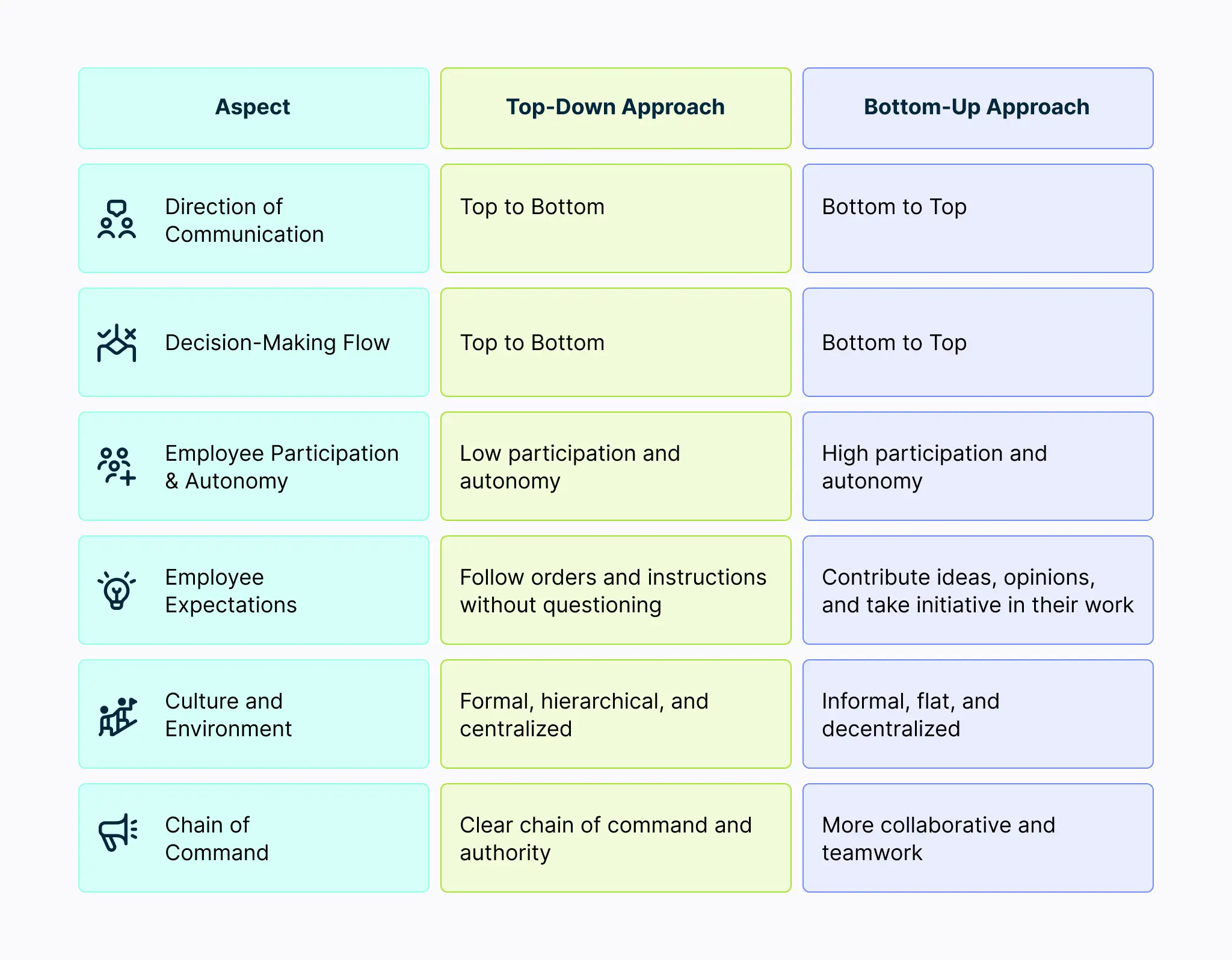Managing a business is no small feat. You have to make decisions, plan strategies, allocate resources, and monitor performance. But how do you decide what is the best way to do these things? Do you follow a top-down approach or a bottom-up approach?
In this blog post, we will explain what these two approaches are, how they work, and what are their pros and cons. We will also give you some tips on when to use each approach and how to balance them.
What is the Top-Down Approach?
A top-down approach is a management style where the leaders or executives set the goals, objectives, and strategies for the organization. They then communicate them to the lower levels of the organization, who are expected to follow them without much input or feedback.
The top-down approach is based on the assumption that the leaders have the best knowledge and vision of the organization and its environment. They are able to see the big picture and make decisions that align with the overall mission and vision of the organization.
The top-down approach is often used in situations where there is a need for speed, efficiency, consistency, and control. For example, when launching a new product, implementing a change, or dealing with a crisis.
What is the Bottom-Up Approach?
A bottom-up approach is where the employees or lower levels of the organization are involved in the decision-making process. They are encouraged to share their ideas, opinions, and feedback with the leaders or executives, who then consider them before making the final decisions.
The bottom-up approach is based on the assumption that the employees have the best knowledge and experience of the daily operations and challenges of the organization. They are able to provide valuable insights and suggestions that can improve the quality and effectiveness of the decisions.
The bottom-up approach is often used in situations where there is a need for innovation, creativity, diversity, and empowerment. For example, improving a process or solving a problem.
Differences Between Top-Down and Bottom-Up Approaches
The main difference between top-down and bottom-up approaches is the direction of the flow of communication and decision-making. In top-down approach, communication and decision-making flow from top to bottom. In bottom-up approach, communication and decision-making flow from bottom to top.
Another difference is the level of participation and autonomy of the employees. Employees have low participation and autonomy in the top down approach. They are expected to follow orders and instructions without questioning or challenging them. In bottom-up approach, employees have high participation and autonomy. They are expected to contribute ideas and opinions and take initiative in their work.
A third difference is the type of culture and environment that each approach creates. In top-down approach, the culture and environment are more formal, hierarchical, and centralized. There is a clear chain of command and authority. In bottom-up approach, the culture and environment are more informal, flat, and decentralized. There is more collaboration and teamwork.

Advantages of Top-Down Approach
Provides clarity and direction for the organization. The goals, objectives, and strategies are clearly defined and communicated by the leaders. This helps to align everyone’s efforts and avoid confusion or conflict.
Ensures consistency and quality across the organization. The decisions are made by the leaders who have the expertise and experience to ensure that they meet the standards and expectations of the organization.
Saves time and resources for the organization. The decisions are made quickly and efficiently by the leaders who have access to all the relevant information and resources. This reduces delays and wastage.
Enhances control and accountability for the organization. The leaders have full authority and responsibility for the outcomes of their decisions. They can monitor and evaluate the performance of their subordinates and take corrective actions if needed.
Advantages of Bottom-Up Approach
Fosters innovation and creativity for the organization. The employees are given opportunities to express their ideas and opinions freely. This stimulates their creativity and generates new solutions.
Improves motivation and engagement for the organization. The employees feel valued and respected for their contributions. This boosts their morale and commitment.
Enhances learning and development for the organization. The employees learn from each other and from the feedback they receive from the leaders. This improves their skills and knowledge.
It builds trust and collaboration for the organization. The employees develop mutual trust and respect with the leaders and with each other. This improves communication and cooperation.
Disadvantages of Top-Down Approach
It can create resistance and resentment for the organization. The employees may feel ignored or imposed upon by the leaders. They may not agree with or understand the decisions that are made for them. This can lead to dissatisfaction or rebellion.
Stifles innovation and creativity for the organization. The employees may not have the chance or the incentive to share their ideas or opinions with the leaders. They may also fear being criticized or rejected by the leaders. This can limit their creativity and potential.
Causes communication and coordination problems for the organization. The leaders may not have enough information or feedback from the lower levels of the organization. They may also have difficulty communicating or coordinating with a large number of subordinates. This can result in errors or misunderstandings.
Creates dependency and complacency for the organization. The employees may rely too much on the leaders for guidance and direction. They may also lose their initiative and sense of responsibility. This can reduce their productivity and performance.
Disadvantages of Bottom-Up Approach
Creates confusion and conflict for the organization. The goals, objectives, and strategies may not be clear or consistent across the organization. There may be too many or conflicting ideas or opinions from the employees. This can lead to confusion or conflict.
Compromises consistency and quality for the organization. The decisions may not meet the standards or expectations of the organization. There may be variations or discrepancies in the quality of work or service across the organization. This can affect the reputation or credibility of the organization.
It can waste time and resources of the organization. The decisions may take too long or too much effort to make. There may be duplication or inefficiency in the use of information or resources across the organization. This can increase costs or delays.
Reduces control and accountability for the organization. The leaders may have difficulty overseeing or influencing the outcomes of their decisions. They may also have difficulty holding their subordinates accountable for their actions or results. This can affect the performance or security of the organization.
When to Use Top-Down Approach and Bottom-Up Approach
There is no one-size-fits-all answer to which approach is better for your business. It depends on various factors, such as:
Nature and complexity of the decision or task
Urgency and importance of the decision or task
Availability and reliability of information and resources
Skills and experience of the leaders and employees
Culture and values of the organization
As a general rule, you should use a top-down approach when you need to:
Make quick and decisive decisions
Ensure consistency and quality across the organization
Deal with a crisis or a change
Have a clear vision and direction for the organization
You should use a bottom-up approach when you need to:
Generate new and diverse ideas
Improve motivation and engagement across the organization
Solve a complex or ambiguous problem
Collaborative and empowering culture in the organization
Top-Down or Bottom-Up: Which Method Should Your Company Choose?
The best way to manage your business is to balance both top-down and bottom-up approaches. You should not rely on one approach exclusively, but rather use them in combination to achieve optimal results. One way to do this is to use an iterative or incremental process, where you alternate between top-down and bottom-up phases. For example, you can start with a top-down phase where you define the overall goal or problem, then switch to a bottom-up phase where you develop or test possible solutions or components, then go back to a top-down phase where you evaluate or refine your solutions or components, then repeat until you reach your desired outcome.
Here are some additional tips on how to balance top-down and bottom-up approaches:
Involve both leaders and employees in setting goals, objectives, and strategies for the organization. This will ensure alignment and buy-in from all levels of the organization.
Communicate clearly and frequently with both leaders and employees about the expectations, progress, and outcomes of the decisions or tasks. This will ensure transparency and feedback from all levels of the organization.
Delegate authority and responsibility to both leaders and employees according to their skills, experience, and interests. This will ensure empowerment and accountability from all levels of the organization.
Recognize and reward both leaders and employees for their contributions, achievements, and improvements. This will ensure appreciation and recognition from all levels of the organization.
Conclusion
Top-down approach and bottom-up approach are two different management styles that have their own advantages and disadvantages. Depending on your situation, you may need to use one approach more than the other, or balance them both.
The key is to understand your goals, objectives, strategies, resources, challenges, opportunities, strengths, weaknesses, culture, values, leaders, employees, customers, competitors, stakeholders, environment, etc.
By doing so, you will be able to choose the right approach for your business.






